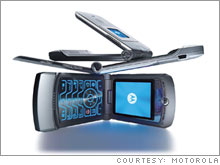Motorola's disconnectThe troubled phone maker has a long way to go before it can turn itself around. Business 2.0's Michal Lev-Ram reports.(Business 2.0 Magazine) -- These are tough times for Motorola. Sales of company handsets plunged in the spring, leading to its second straight quarterly loss. Its stock is trading at a 52-week low. Amid all the bad news, CEO Ed Zander is fighting to keep his job and activist shareholder Carl Icahn is circling. As if that weren't bad enough, Motorola just ceded its spot as the world's second-largest phone maker to Samsung Electronics, the Korean giant once known for its cheap knockoffs.
What a difference three years make. It wasn't that long ago that Motorola (Charts, Fortune 500) was riding high on the blowout success of its RAZR phone. Today, the once-revolutionary clamshell device is overshadowed by a slew of competing handsets, including the gorgeous new iPhone from Apple (Charts, Fortune 500). Now Motorola is all but giving the RAZR away. Motorola needs to turn itself around and fast. So what's the company's game plan? It's throwing all of its eggs into the RAZR basket, with plans to release in coming weeks a slimmer version that it hopes will be as big of a hit as -- if not bigger than -- its namesake. That's a bad bet. To stay relevant, Motorola needs not one blockbuster phone. It needs several -- just like Nokia, the archrival phone maker who overtook Motorola as the world's largest phone maker nearly a decade ago. "Motorola has been using the RAZR as a cash cow for too long," says Tina Teng, a wireless analyst with El Segundo, Calif.-based research firm iSuppli. One-hit wonders don't work in today's global wireless market, where mobile phone makers need iconic devices that appeal to different cultures and sell at a variety of prices. That means knowing what consumers in different markets -- whether in China, France or Zimbabwe -- really want. Instead of banking on the RAZR2, Motorola should be rolling out a slew of innovative new phones, including high-speed 3G and multimedia devices for developed markets in the United States, Europe and parts of Asia and lower-end models for the developing world. The broader approach is one reason why Nokia (Charts) has been so successful. The Finish giant sells a wide range of popular product lines, from the high-end multimedia Nseries (including the uber-stylish N95, which sells for $750) to cheap, barebones handsets sold in countries like India and throughout Africa. Emerging markets are key. Some 80 percent of mobile phone subscribers will come from developing countries in five years. In India, one of the world's fastest-growing, Nokia already commands 70 percent of the market. Motorola's share? A paltry 10 percent. To be fair, Motorola sells a popular PDA in China called the Ming, whose finger-writing recognition touchscreen and business card reader have been a hit with consumers. But the Ming is the exception. "To achieve market share growth or to maintain current market share, all handset vendors will have to address the developing world," says Shailendra Pandey, an analyst with New York-based firm ABI Research. Samsung has overtaken Motorola as the world's No. 2 mobile phone maker in part because it appeals to a broad consumer base. The Korean electronics giant caters to the high-end of the lower-end market -- selling phones with a few bells and whistles for $70 instead of $20 -- while drawing the wealthiest shoppers with TV and music-playing phones. Can Motorola revive itself? Yes. The company is, after all, no stranger to turnarounds. That's exactly what the original RAZR did for the company back in 2004. Don't discount any company brilliant enough to sell 100 million phones that had little more than thinness going for it. But the big lesson of the RAZR is that today's hit could easily be tomorrow's also-ran. Even if RAZR2 becomes the next must-have phone, analysts aren't expecting Motorola to bounce back as quickly as it did before. "[W]e believe that market-share losses are still likely to continue given a sparse product portfolio as we believe several phones that were slated to launch next year were recently cancelled," Goldman Sachs analysts wrote in a recent note to investors. Their report said a turnaround at Motorola would be a "multiyear effort." What's more, Motorola has much work to do before it can be seen as a credible player in the developing world. Neil Mawston, associate director at research firm Strategy Analytics, says it takes "time, resources and deep pockets" to build the distribution networks and establish the government ties that handset makers need to crack emerging markets. And the one thing Motorola doesn't seem to have is a whole lot of time. |
Sponsors
|

